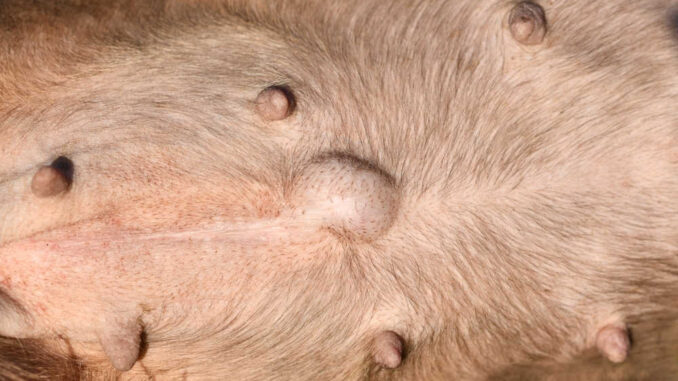
This article was updated on June 11th, 2023
Spay surgeries are the ‘bread and butter’ of the veterinary industry, and it would not be unusual for a vet to perform one or two spays every working day. While complications can occur, it is uncommon for a dog to herniate after a spay surgery.
After 10 years of clinical experience, I have only seen this happen in one patient and they had chewed out all of their stitches when at home, the day after their procedure. Regardless, understanding that a post-op hernia is possible and knowing the signs to look for is important.
What is a hernia in dogs?
A hernia is what happens when something that should be inside the body sticks out through muscles or tissue that have opened up or weakened. This swelling will be under the skin.
Smaller hernias will often contain fat or omentum, while larger hernias may contain organs such as the intestines.
Why do dogs develop hernia after spaying?
A hernia can occur when the muscle is not completely closed or when it is weakened. The abdominal muscles are cut through, in order to access the uterus and ovaries during a spay surgery. These muscles then need to be sutured back together, but complications can arise and the closure can fail.
Hernias are uncommon but may be seen if the dog chews at their wound or they are very active shortly after their procedure. Those with weak muscles, such as older dogs or dogs with chronic illnesses, may be more likely to herniate.
What are the signs and symptoms of hernias in dogs?
If a hernia were to occur, it would be visible as a swelling under the incision, near the belly button of the female. This swelling can be difficult to differentiate from a seroma (fluid buildup), hematoma (blood build up) or infection. It tends to feel soft and squishy and it may be something that can be ‘pushed’ back inside, only for it to pop back out right when you take your finger away.
Your female may not show any symptoms and may continue to act as normal, despite their hernia. However, if the hernia becomes strangulated (the blood supply is compromised), your female will suddenly become very unwell and will experience intense pain.
Does dog breed affect the occurrence of a hernia after spaying?
We know that some breeds are more predisposed to congenital hernias than others. This means they are more likely to be born with hernias. This predisposition should not make them more prone to hernias after surgery.
As larger and heavier dogs will be putting more pressure on their surgical wound, these are the dogs most likely to herniate. Similarly, any breed that is very energetic or hyperactive may be more likely to experience post-op complications such as hernias.
When to call your vet for diagnosis
Any notable swelling that occurs at the surgical incision site is something we should bring to the vet’s attention. For most, swelling will simply be due to inflammation in the area. However, it is a good idea to rule out a hernia.
Your vet will palpate the lesion and may also discuss imaging (such as an x-ray and/or abdominal scan) in order to determine if they are dealing with a hernia or not.
Treatment costs
Hernias will generally have to be repaired surgically. This is a relatively minor procedure, whereby the hernia is ‘pushed’ back inside the abdomen and the muscle wall is sutured closed under general anesthetic.
A surgery like this can cost from $200-500, depending on the size of the dog and extent of the hernia. If the hernia was caused by the dog (for example, if they have chewed at their wound), the owner will likely have to foot the bill.
In some instances, the vet may cover the cost of post-op complications or may ask the owner to just cover the cost of the supplies used.
Recovery from hernia after spaying
Recovery time after the procedure is similar to recovery time after a spay; about 1-2 weeks. Indeed, this procedure is quicker and less invasive than the spay surgery itself.
Owners will need to strictly rest their dogs, to ensure the hernia does not recur and the wound can heal. Licking and chewing must be avoided at the incision site, and this can mean the use of a buster collar and/or pet t-shirt.
Owners should be given post-op instructions to follow and should give their dogs any medicine prescribed. This may include some pain relief and anti-inflammatories. When pain is well controlled, dogs are much less likely to try and lick or chew at their wound.
Frequently Asked Questions
- Can dog hernias be prevented?
We can help prevent post-op hernias by resting our dogs as advised and by ensuring they do not lick or chew at their lesion. However, not all hernias can be predicted or prevented.
- Can dog hernias recur after surgical repair?
While uncommon, it is possible for the hernia to occur again, yes. If this does occur, it will generally do so within the first week or two after surgery. This is when the muscle is weakest.
- Are there any lifestyle changes I should make for my dog with hernia?
While your dog has the hernia, they should be able to act as normal. However, we do need to keep an eye on the hernia, to monitor for any redness, pain or increase in size. Similarly, if it becomes hard, this is something a vet needs to look into urgently, in case the contents of the hernia have strangulated.
- Can dog hernias heal without intervention?
Some very small congenital hernias may knit together when the dog is still growing. This is not something we generally see in post-op hernias, and the muscle wall usually needs to be surgically repaired.
- Is it normal for my dog to have a lump after being spayed?
Sometimes a dog will develop some swelling and a small lump after a spay surgery. This can be due to fluid buildup and will usually disappear within a few days. However, larger lumps or those that persist could be a sign of a complication.
- Are there complications I should watch out for after hernia surgery?
After the surgery, owners need to monitor the wound to ensure the hernia does not recur. They should also keep an eye out for signs of infection, such as redness, discharge or a bad smell.
Disclaimer: This website's content is not a substitute for veterinary care. Always consult with your veterinarian for healthcare decisions. Read More.


My kelpie is near on 9 years old and over the last 12 months a lump as formed and grown where her belly button is, you can touch it and press it and she doesn’t seem too bothered. She was spayed as a young pup. Is it possible this is a hernia ?
Hi there Millie and thank you for this question. If in the location of her belly button, it could be a hernia. This is especially true if we can ‘push it back in’. However, umbilical hernias are not so common in older dogs. It is best to have your vet examine the area. This may include an ultrasound, if they’re unsure what the swelling is.
Dr Linda Simon MVB MRCVS
“The information on this website is not a substitute for in-person veterinary care. Always seek advice from your veterinarian if you have concerns about your pet’s medical condition.”